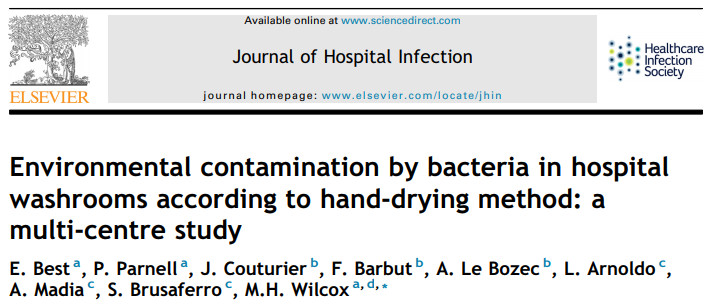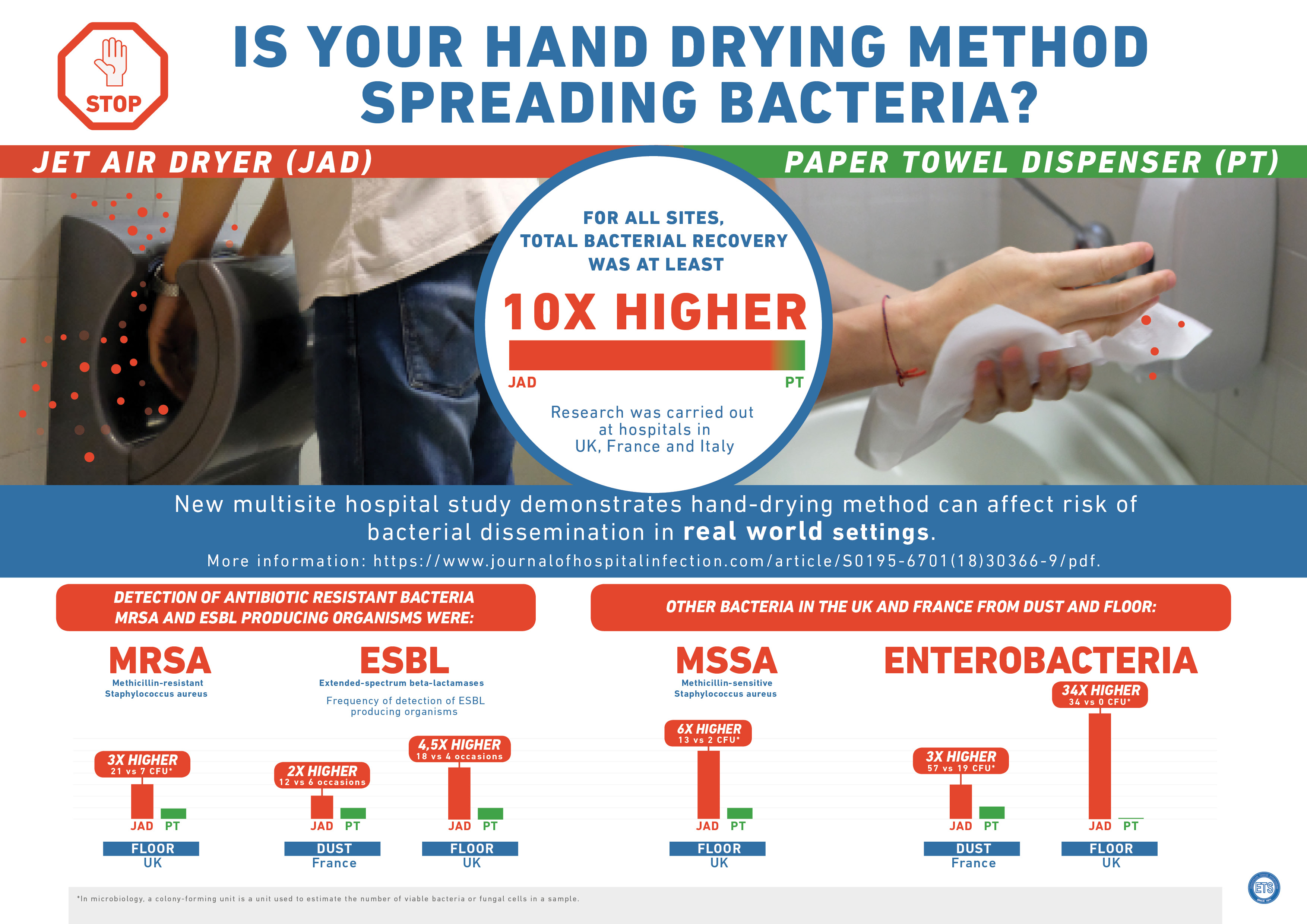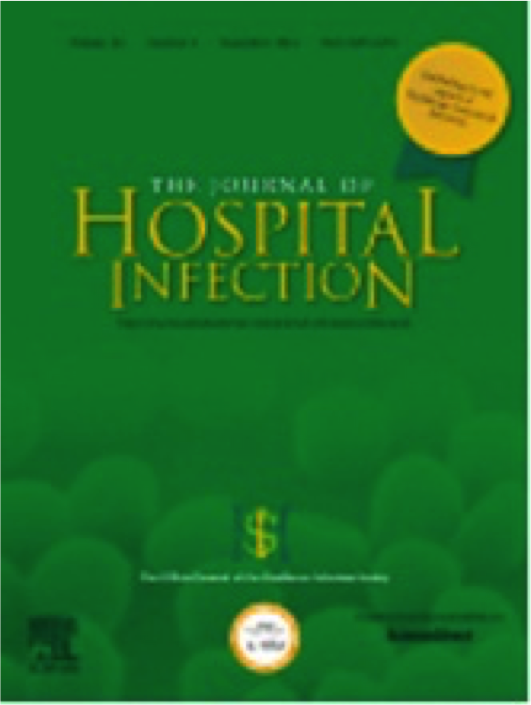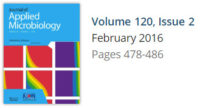Multisite hospital study demonstrates hand drying method can affect risk of bacterial dissemination in real world settings
Findings have important implications for minimising risk of cross infection in hospital washrooms
A new, real-life multisite study has found that washrooms have significantly less bacterial contamination when equipped with paper towels for hand drying instead of using jet air dryers.
 The study, led by Professor Mark Wilcox of the University of Leeds and Leeds Teaching Hospitals, was carried out in France, Italy and UK and examined the extent of environmental contamination in hospital washrooms from potential bacterial pathogens according to hand drying method. Antibiotic-resistant bacteria – including MRSA and ESBL-resistant enterococci – were detected more frequently in the washrooms when jet air dryers were in use.
The study, led by Professor Mark Wilcox of the University of Leeds and Leeds Teaching Hospitals, was carried out in France, Italy and UK and examined the extent of environmental contamination in hospital washrooms from potential bacterial pathogens according to hand drying method. Antibiotic-resistant bacteria – including MRSA and ESBL-resistant enterococci – were detected more frequently in the washrooms when jet air dryers were in use.
“The findings will have important implications for hand drying guidance in healthcare settings,” commented Professor Wilcox, “and they should be of particular interest to infection prevention and control doctors and nurses, procurement managers and all responsible for minimising the spread of cross–infection.”
The study design was conceived and carried out independently by research scientists at three different hospitals: Professor Wilcox at Leeds General Infirmary, (Leeds Teaching Hospitals), UK; Professor Frédéric Barbut of the Infection Control Unit at Hospital Saint-Antoine (AP-HP), Paris, France; and Professor Silvio Brusaferro, of the Department of Medicine, Udine University Hospital, Italy.
The study compared two washrooms per hospital – each had paper towel dispensers and jet air hand dryers, but only one drying method was available to use at any given time. Each was frequented by patients, visitors and staff. A crossover design compared contamination levels within each over a 12-week period. During the study, 120 sampling sessions in total in each of the three hospitals were carried out. The independent study was undertaken in 2017 and supported with a grant from ETS.
Presence of Antimicrobial resistant microorganisms (AMR)
Bacteria recovered included methicillin susceptible (MSSA) and resistant Staphylococcus aureus (MRSA), enterococci and enterobacteria, including ESBL (Extended-spectrum β-lactamase producers) producing bacteria.
Key findings
In general, bacterial contamination was lower in washrooms using paper towels (PT) than those using jet air dryers (JAD), and total bacterial recovery was significantly greater from the JAD outer surface versus the PT dispenser at all three sites (median 100-300—vs 0-10 colony-forming units (CFU) respectively all p<0.0001). While contamination in France and UK was similar, it was markedly lower in Italian washrooms, thought to be due to a combination of a lower footfall and different cleaning practices.
There were differences between the three locations, and significantly more bacteria were recovered from the floors of JAD washrooms in the UK and France (median 24 v 191 CFU, p<0.00001). In the UK overall recovery of MSSA was 3 times more common and 6-fold higher from JAD versus PT surfaces (both p<0.0001).
“MRSA was recovered 3 times more often in UK washrooms (21 vs 7 CFU) from the JAD outer surface or on the floor beneath compared with respective PT sites,” explained Mark Wilcox of his part of the study at Leeds General Infirmary. “There were also significantly more ESBL-producing  bacteria recovered from UK washroom floors during JAD versus PT use.”
bacteria recovered from UK washroom floors during JAD versus PT use.”
Commenting on the results from Hospital Saint-Antoine, AP-HP, Professor Frédéric Barbut said, “In France we saw significant differences in bacterial contamination between the two types of hand drying method. Higher numbers of bacteria were recovered from the floors and drier surfaces in the JAD condition than when using PT. In particular ESBL-bacteria were recovered from dust twice as much during JAD versus PT use.”
Silvio Brusaferro, Professor of Hygiene and Public Health, with regard to the experience at Udine hospital in Italy stressed the importance of selecting a hand drying system that prevented the spread of microorganisms. “We found the dispersion of microorganisms to be more than 25 times greater with jet air dryers than single use paper towels,” he explained. “Indeed, Italian infection control personnel traditionally avoid the use of jet air dryers in hospitals.”
Use this link to have access to the complete study.
Complements previous research findings
While hand hygiene is a fundamental component of infection prevention, there are few studies on the contribution of hand drying method to the dissemination of potential pathogens. Previous studies, including those undertaken by Professor Wilcox and Keith Redway of the University of Westminster, also found that electric dryers can contaminate both the air and the surfaces with bacteria and viruses. (see these studies below)
“We already had both laboratory and in situ evidence. Now with this study we also have real-world evidence that jet air dryers spread greater levels of bacteria,” explained Professor Wilcox. “This latest research demonstrates that paper towels offer the most hygienic way to dry hands and minimize the spread of bacteria including MRSA, enterobacteria and enterococci following a visit to the washroom.”
1. Microbiological comparison of hand drying methods: the potential for contamination of the environment, user and bystander. E.L. Best,1 P. Parnell,1 M.H. Wilcox 1,2 – Microbiology Department, Old Medical School, Leeds General Infirmary, Leeds Teaching Hospitals NHS Trust1 & University of Leeds,2 Leeds LS1 3EX, UK. Journal Hospital Infection 2014; 88:199-206. See also the page: Microbiological comparison of hand drying methods …
2. “Comparison of different hand-drying methods: the potential for airborne microbe dispersal and contamination” and is authored by Keith Redway (Department of Biomedical Sciences, Faculty of Science and Technology, University of Westminster, London, UK) and by E.L. Best (Microbiology Department, Old Medical School, Leeds General Infirmary, Leeds Teaching Hospitals NHS Trust, Leeds UK). Journal Hospital Infection 2015;89:215-217. See also the page: Comparison of different Hand drying methods
3. Evaluation of the potential for virus dispersal during hand drying: a comparison of three methods P.T. Kimmitt and K.F. Redway. Department of Biomedical Sciences, Faculty of Science and Technology, University of Westminster, London, UK. Journal of Applied Microbiology 120, 478–486 © 2015 The Society for Applied Microbiology. See also the page: Hand drying with single-use towels reduces the risk of the transmission of viruses
4. Pilot Study to determine whether microbial contamination levels in hospital washrooms are associated with hand-drying method
M.H. Wilcox Correspondence information about the author M.H. Wilcox, E.L. Best P. Parnell Microbiology, Leeds Teaching Hospitals NHS Trust & University of Leeds, Leeds, UK Journal of Hospital infection 2017; 97 200-2003. See also the page: Pilot Study
This page is also available in: French German Italian Polish Spanish

















